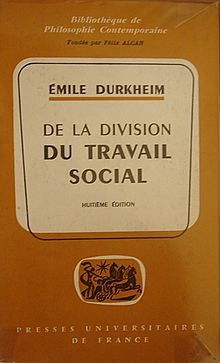- The Division of Labour in Society
-
Sociology Portal Theory · History Research methods Topics · Subfields Cities · Class · Crime · Culture
Deviance · Demography · Education
Economy · Environment · Family
Gender · Health · Industry · Internet
Knowledge · Law · Medicine
Politics · Mobility · Race and ethnicity
Rationalization · Religion · Science
Secularization · Social networks
Social psychology · StratificationCategories · Lists Journals · Sociologists
Article index · OutlineThe Division of Labor in Society (French: De La Division Du Travail Social) is the dissertation of French sociologist Émile Durkheim, written in 1893. It was influential in advancing sociological theories and thought, with ideas which in turn were influenced by Auguste Comte. Durkheim described how social order was maintained in societies based on two very different forms of solidarity (mechanical and organic), and the transition from more "primitive" societies to advanced industrial societies.
Durkheim suggested that in a "primitive" society, mechanical solidarity, with people acting and thinking alike and with a collective or common conscience, is what allows social order to be maintained. In such a society, Durkheim viewed crime as an act that "offends strong and defined states of the collective conscience."[1] Because social ties were relatively homogeneous and weak throughout society, the law had to be repressive and penal, to respond to offences of the common conscience.
In an advanced, industrial, capitalist society, the complex division of labor means that people are allocated in society according to merit and rewarded accordingly: social inequality reflects natural inequality. Durkheim argued that moral regulation was needed, as well as economic regulation, to maintain order (or organic solidarity) in society with people able to "compose their differences peaceably".[2] In this type of society, law would be more restitory than penal, seeking to restore rather than punish excessively.
He thought that transition of a society from "primitive" to advanced may bring about major disorder, crisis, and anomie. However, once society has reached the "advanced" stage, it becomes much stronger and is done developing. Unlike Karl Marx, Durkheim did not foresee any different society arising out of the industrial capitalist division of labour. He regards conflict, chaos, and disorder as pathological phenomena to modern society, whereas Marx highlights class conflict.
Contents
Contents
Introduction
BOOK I THE FUNCTION OF THE DIVISION OF LABOR
Chapter I: The Method of Determining This Function
Chapter II: Mechanical Solidarity, Or Solidarity by Similarities
Chapter III: Solidarity Arising From the Division Of Labor, or Organic Solidarity
Chapter IV: Another Proof of the Preceding Theory
Chapter V: The Increasing Preponderance of Organic Solidarity and Its Consequences
Chapter VI: The Increasing Preponderance of Organic Solidarity and Its Consequences (cont.)
Chapter VII: Organic Solidarity And Contractual Solidarity
BOOK II THE CAUSES AND CONDITIONS
Chapter I: The Progress of the Division of Labor and Of Happiness
Chapter II: The Causes
Chapter III: Secondary Factors
Chapter IV: Secondary Factors (cont.)
Chapter V: Consequences of the Foregoing
BOOK III THE ABNORMAL FORMS
Chapter I: The Anomic Division of Labor
Chapter II: The Forced Division of Labor
Chapter III: Another Abnormal Form
See also
- Rules of the Sociological Method (1895)
- Suicide (1897)
- The Elementary Forms of Religious Life (1912)
External links
- De la division du travail social : étude sur l'organisation des sociétés supérieures (1893) - French version in the Internet Archive
- French edition full text download
References
- ^ Durkheim, Emile. The Division of Labor in Society. Trans. Lewis A. Coser. New York: Free Press, 1997, pp. 39, 60, 108.
- ^ Rock, Paul (2002). "Sociological Theories of Crime" in Maguire, Mike, Rod Morgan, and Robert Reiner, The Oxford Handbook of Criminology. Oxford University Press.
Categories:- Sociology books
- Criminology publications
- 1893 books
- Sociology book stubs
Wikimedia Foundation. 2010.


